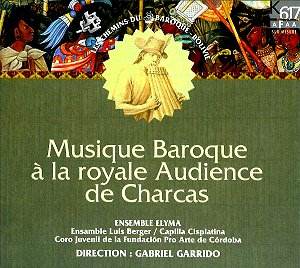The French label K617 has released a number of
discs of Spanish American baroque music performed by Gabriel Garrido’s
Ensemble Elyma, teamed up with various South American ensembles
and children’s choirs. This was a major recording project of the
1990s, involving large financial input from a multitude of French
ministries and Departments, various international festivals and
broadcasting organisations. The results on CD were the exposure
of fascinating music, unknown but of the highest quality. Generally
the performances have been something of a mixed bag. This disc
is one of the most musically consistent of the series. Some excellent
solo singers are accompanied by a host of instrumentalists who
play with polish and flare, especially the violins, under the
able leadership of Manfredo Kraemer.
This reviewer has previously lamented the contribution
of some rather inferior children’s choirs in discs of this "Paths
of the Baroque" series. They seem to have had various names
and come from various cities, but all seem to have been directed
by one Emma Sanchez. One begins to wonder if they were not put
together especially, as each recording came about. In this disc
the Coro Juvenil de la Fundación Pro Arte de Córdoba,
under Emma Sanchez, features in the booklet but is rather harder
to find in the recording. Thus, one of the main disadvantages
of the series is removed from this particular disc.
The music itself is extremely good. The Italian
style arrived late in Spanish America, but when it did, native
composers took to it with alacrity. The composers represented
here were generally holders of the post of Maestro at the
Cathedral in Sucre (Bolivia), originally called La Plata after
the extensive silver mines that gave the city the wealth that
contributed in no small measure to this musical flowering. Although
the church dominated, all the music on this disc seems to be secular;
principally villancicos and cantatas. It is tuneful, melodically
imaginative and colourful. The solo sopranos Rosa Dominguez and
Silvia Perez Monsalve, and the mezzos Alicia Borges and Roberta
Invernizzi are uniformly excellent and, with the violins, carry
most of the passagework. There is a sense of abandon in both the
music and the performances that is infectious (Samples 1 and 2).
There is also very good wind playing with oboe and bassoon. However,
as on several other discs in the series, there is a question hanging
over the bajones. These large, reedy panpipes were a feature
of this period and location (indeed, the CD cover depicts a man
playing bajones.) On other discs in the series they have
been mentioned, and discussed in the booklet, but remained inaudible
in the recording. In this programme four tracks include specific
mention of bajones in their titles; (Track 3 "Con
dos bajones"; track 7 "Con bajón y fogote";
track 9 "Con violin y bajón"; and track 10 "Con
bajón y fogote"). However, a sample of track 7 shows
the sound of an oboe. Nils Ferber, who gets a credit for it in
the booklet, plays it. But nowhere is a player (or players, for
track 3) of bajones mentioned in personnel list, or booklet note.
This seems to be a very strange omission of one of the instrumental
features that makes this music distinctly Spanish American
rather than just Spanish. (Sample 3)
Unfortunately, although the presentation is of
the usual glossy standard of K617, the notes in the booklet are
rather confused and incomplete. There are no track timings listed,
recording details are buried on page 14 of 24 and the programme
note, while reasonably detailed about the development of La Plata
/ Sucre, gives no real information about the music. Hence this
writer’s earlier supposition that the works recorded appear
to be secular. This is gleaned only from the titles in Spanish
as there are no texts or translations. With music that is bound
to be unknown, this is a distinct pity. In the final analysis,
this disadvantage should not put the listener off this disc as
the singing, playing and the music itself are far more consistent
than the accompanying writings. Of all the "Paths of the
Baroque" discs from K617, this disc is probably the easiest
to recommend as a consistently well-performed offering.
Peter Wells
see also
VÊPRES
DE L'ASSOMPTION
Lambert
de BEAULIEU / Baltasar de BEAUJOYEULX: Le Balet Comique de la
Royne
Tomas
Torrejon y VELASCO (1644-1728) Musique à la Cité
des Rois

